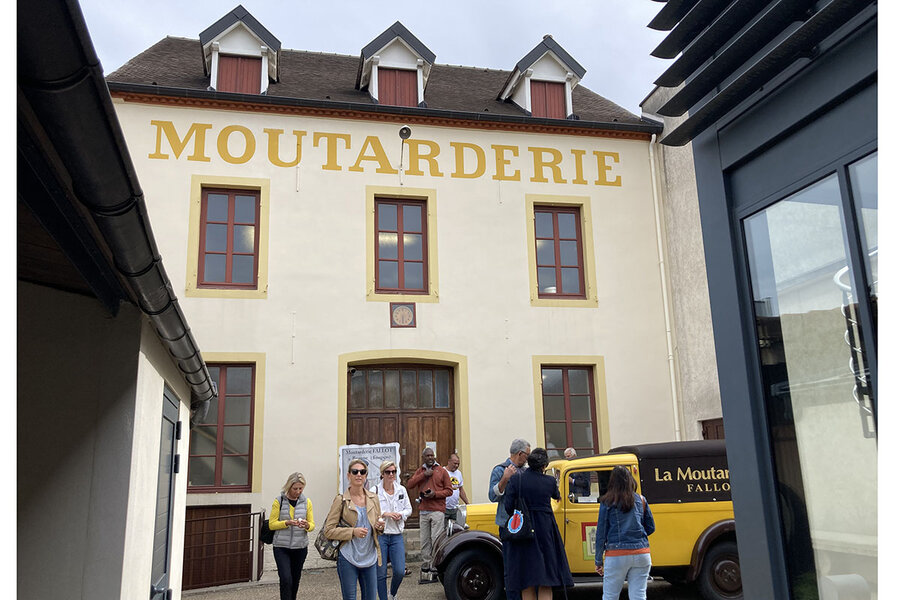Sans mustard? France gets creative amid shortage.
Loading...
| Beaune, France
France is in the midst of a prolonged mustard shortage that has left supermarket shelves sapped of 21% of its stock of the beloved condiment. Mustard producers have had to put caps on in-store purchases to minimize hoarding.
Now, with mustard in high demand due to drought and war, French farmers are looking to innovate and stake a larger claim in the market for France’s gastronomical heritage.
Why We Wrote This
A story focused onThe French are doggedly seeking mustard anywhere they can get it as grain shortages crimp production. But the surge in demand is also opening up opportunities for mustard innovation.
French mustard fields have seen production cut by two-thirds in five years, from 12,000 tons in 2017 to 4,000 in 2021. And imports aren’t able to make up the difference due to foreign grain shortages. But the overwhelming demand has sent prices surging and has encouraged local mustard growers to increase production.
Some mustard growers are testing new seed varieties that are more resistant to climate change’s unpredictable weather patterns. And producers are looking for ways to widen the scope of what consumers want. Mustard producer Patrice Boudignat has developed sample versions of mustard oil and mustard-flavored chocolate, for example.
“If we want to reduce the costs and inconveniences of transportation and have a shorter supply circuit, then we need to make more room for our local product,” he says. “It’s our heritage that we’re trying to preserve every day.”
A half-dozen tourists huddle around a metallic counter at the Edmond Fallot mustard mill, as company employee Martine Dupin pumps various blends of Dijon mustard onto miniature wooden spoons. There are gingerbread, blackcurrant, and whole seed “old style” varieties, among others. Faces contort as the pungent zing rises to their nostrils.
“I’m definitely planning to buy some mustard today,” says Elisabeth Soulier, from Poitiers. “It’s great in a sauce for cooked rabbit, or in a vinaigrette for salad. It’s hard to find mustard anywhere anymore. And Burgundy mustard is so much better than the rest.”
Like her fellow tour group members, Ms. Soulier will be able to buy her pot of mustard in the gift shop – but just one. France is in the midst of a prolonged mustard shortage that has left supermarket shelves sapped of 21% of its stock of the beloved condiment. Edmond Fallot and its competitors have had to put caps on in-store purchases to minimize hoarding.
Why We Wrote This
A story focused onThe French are doggedly seeking mustard anywhere they can get it as grain shortages crimp production. But the surge in demand is also opening up opportunities for mustard innovation.
Now, with mustard in high demand due to drought and war, French farmers are looking to innovate and stake a larger claim in the market for France’s gastronomical heritage. They say they’re ready to move beyond the shortages and find opportunities for growth.
“Canadian mustard grains are very good, but mustard is emblematic of France,” says Patrice Boudignat, a mustard producer with 12 acres of land in the Ile-de-France region. “If we want to reduce the costs and inconveniences of transportation and have a shorter supply circuit, then we need to make more room for our local product. It’s our heritage that we’re trying to preserve every day.”
A hard year for mustard
Mustard is the third most popular condiment in France, behind salt and pepper, and the French are the No. 1 consumers in Europe of the spicy yellow paste, at approximately 2.2 pounds annually per person.
The Burgundy region, and specifically the city of Dijon, has been at the center of mustard-making since the Middle Ages. In recent years, Burgundy has counted some 300 producers, capable of producing more than 10,000 tons of grains annually.
But mustard fields have been hit with insect attacks, which farmers have been unable to contain due to French laws on the use of insecticides since 2019. The region has seen its production cut by two-thirds in five years, from 12,000 tons in 2017 to 4,000 in 2021.
Even in good years however, Burgundy producers are not able to meet French consumer demand for moutarde with local grains, which require around 30,000 tons annually. Major labels have relied heavily on the Canadian market to fill the gaps. But drought conditions throughout 2021 – blamed largely on climate change – abruptly cut production in half.
The war in Ukraine has meant that France can’t count on grains from Russia and Ukraine, which produce a milder, yellow mustard version, to increase supply – assuming the French would buy it. The combined effect has put increased pressure on local producers to meet market demand.
“This is a situation affecting the whole world,” says a spokesperson for Maille, a market leader in Dijon mustard. “It’s temporary and out of our control.”
Edmond Fallot, which represents 5% of the French market, increased production by 20% to 25% at the beginning of the year. But they can’t do more.
“We have a small facility. We still use a stone mill to grind our seeds, something that big distributors abandoned long ago,” says Marc Désarménien, the owner of the company, which has been family-owned since 1840 and uses 100% Burgundy-grown seeds. “They want to produce fast, but they lose quality. I’m the third-generation owner of this business and we’ve always favored quality over quantity.”
“Periods of crisis represent opportunities”
The overwhelming demand has sent prices surging for next year’s mustard harvest, and has encouraged local mustard growers to increase production and brought new farmers to the crop, in an attempt to bring mustard back to its French roots and reduce the country’s reliance on Canada.
The Burgundy Mustard Association says the price for Burgundy seed is expected to double next year as compared to last: €900 euros per ton in 2021 versus an anticipated record €2,000 euros for 2023. And the Chamber of Agriculture for the Cote d’Or region says the number of producers has since risen from 160 to 500, with a goal to produce 15,000 tons of seed by 2023 – 40% of producers’ needs.
The challenge now for mustard producers is to make this newfound bounty sustainable and resilient against the sorts of conditions that caused the shortages this year, including insects and drought.
“Periods of crisis represent opportunities, but the concern is that these new [growing] methods are not preserved in the long run,” says Stéphane Fournier, a professor of innovation and sustainable development at the Institut Agro Montpellier. “All of us – citizens, nonprofits, and all the players involved – need to continue to develop alternative methods.”
Local mustard growers have heard the call for innovation. Some are testing new seed varieties that are more resistant to the unpredictable weather patterns that have come with climate change. Small-scale farms in regions not traditionally known for mustard are popping up.
And producers are looking for ways to widen the scope of what consumers want. Mr. Boudignat in Ile-de-France has developed sample versions of mustard oil and mustard-flavored chocolate, in addition to his more traditional varieties.
Edmond Fallot also now sells a sweet and savory mustard flavored with a pain d’épices (spice bread) blend, compliments of Mulot & Petitjean, a family-owned company in Dijon since 1796. In turn, Mulot & Petitjean has begun incorporating Edmond Fallot mustard into their dessert breads.
“We’re always searching for innovation and so is the consumer,” says Catherine Petitjean, the ninth-generation head of Mulot & Petitjean, based in Dijon. “We want to remain anchored in tradition but it’s the 21st century. We have to keep developing or we won’t move forward.”
Responsible consumers
Local producers are confident that consumers will follow them. French consumers value knowing the source of their food and appreciate products that circumvent large supply chains more than ever, especially since the COVID-19 pandemic hit. They put food origin as the top criteria for buying fruits and vegetables, according to a 2020 Ipsos poll, with 63% of those polled saying they bought local products whenever possible.
“We’re seeing that people are becoming more and more attentive to what they’re consuming, to know not only where [their food] was produced but also how it was produced,” says Marc De Nale, the director-general of Demain La Terre, a nonprofit that works with fruit and vegetable producers to promote sustainable development. “They want to know that farmers are engaged [in sustainable practices], have progress in mind, to produce better while also protecting the environment.”
As French consumers wait out the mustard shortage, some are supplementing their cravings with similar products from Algeria and Poland now filling supermarket shelves. Others have paid for train tickets to the Burgundy region in hopes of scoring a pot from local producers or are paying a fortune on Amazon. Still more are trying to make their last pot of Dijon mustard last as long as possible, until the tangy zest of this homegrown culinary hero makes its way back to the stores.
“I always use mustard when I cook, it’s simply part of our traditional cuisine,” says Guy Benoît, a native of Beaune, during a mustard tasting at Edmond Fallot. “I still have my little reserve of two pots at home because unless you get to the supermarket at 8 o’clock in the morning, there’s nothing left. But I know it’s going to come back.”
Editor's note: The original version mistakenly misnamed the Edmond Fallot mustard mill.










